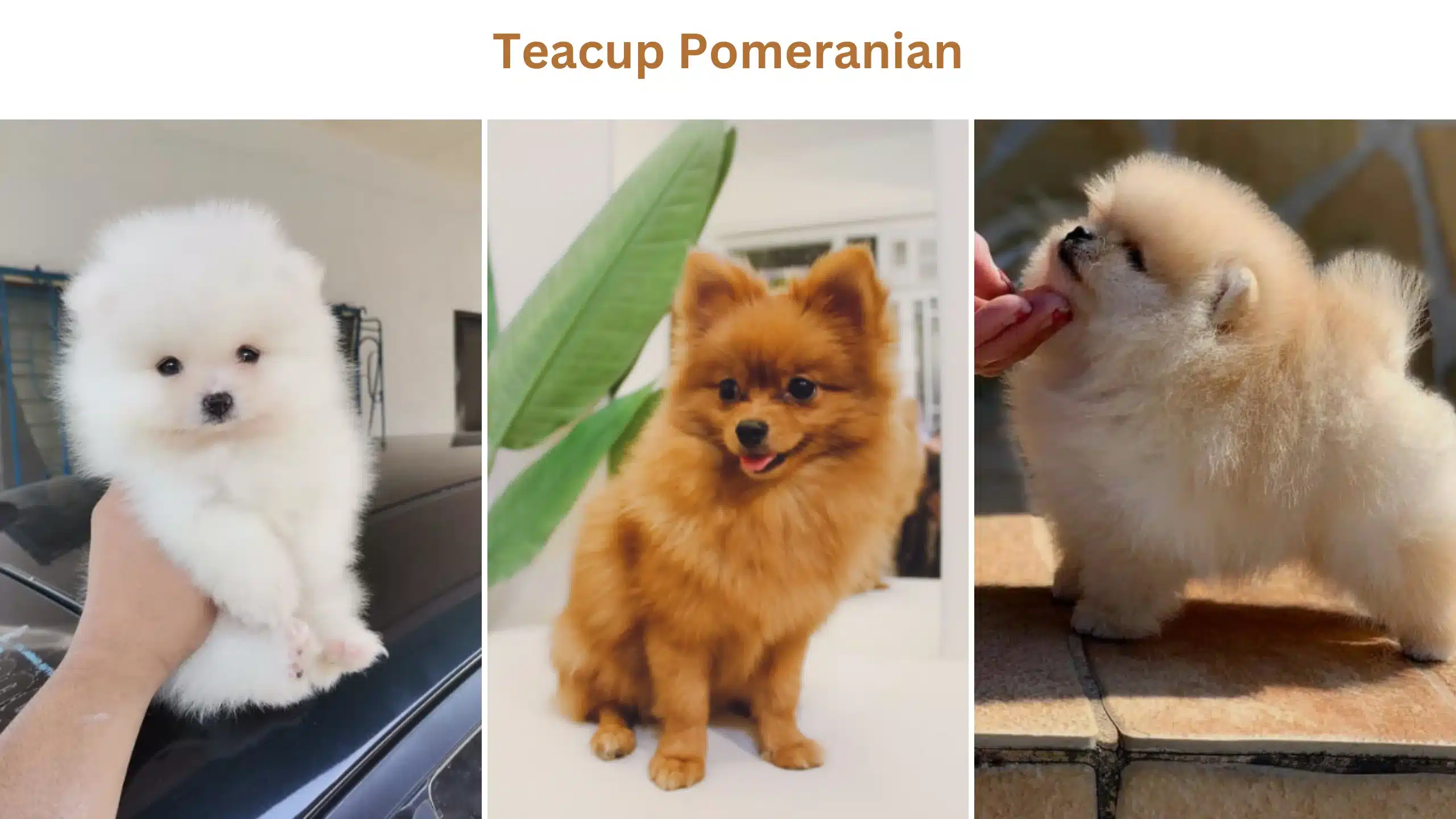Last Updated on February 11, 2024 by Aftab Tariq
Teacup Pomeranian is a very cute and loyal dog that has been getting more and more popular. Recently, they’ve been advertising smaller versions of this dog, like the Teacup Pomeranian, which is even tinier than the regular ones.
The Pomeranian, also known as Pom, Pom Pom, Zwergspitz, Zwers, Spitz Enano, Spitz Main, Deutsche Spitze, or Loulou, is a small dog with a big personality and a lot of love to give. They are smart and devoted to their family but can also be a bit independent.
Pomeranians are very friendly and playful, getting along well with strangers, other pets, and children. However, they may sometimes forget their small size and challenge bigger dogs. It’s important to train them early to prevent this. Pomeranians enjoy attention and affection, and when they get enough exercise, they love to cuddle up on your lap.

People are really into these tiny dogs now, especially the teacup Pomeranians. They’re advertised as small enough to fit in your hand and they promise to be more than just cute.
Tiny puppies known as teacup puppies are sparking more debates lately, but that doesn’t mean they’re not popular. Some people believe their controversial reputation makes them even more desirable. Dog lovers might not like hearing about teacup puppies because it reminds them that some breeders use the term as a sales gimmick to attract buyers.
History of Teacup Pomeranian
Pomeranians are known for being small, cute, and lovable. Surprisingly, their ancestors were ancient Spitz sled dogs. The ancestors of Pomeranians were working dogs in cold places with pointy ears like other Wolf Spitz-type dogs.
But, over time, they became smaller as people preferred having tiny, cute pets at home instead of big working ones. This kind of dog got its name from the Pomerania region in Germany and Poland, where it started in the 18th century.
Royals like Queen Victoria made these dogs famous. Changing from a working animal to a fashionable pet made these dog breeds popular worldwide.
Teacup Pomeranian Mean?
Teacup Pomeranian is a term commonly used for small Pomeranians. The word teacup comes from a time when tea was served in very tiny and delicate cups. Calling them Pomeranian teacups is just another name for the show-type Pomeranian.
But it’s important to know that there are no officially recognized dog breeds like Teacup Pomeranian, Miniature Pomeranian, Teddy Bear Pomeranian, Toy Pomeranian, Pocket Pomeranian, Miniature Poms, Mini Pomeranian, or Pomeranian Teacup. The only recognized type by the AKC (American Kennel Club) is the Pomeranian dog.
Appearance of Teacup Pomeranian
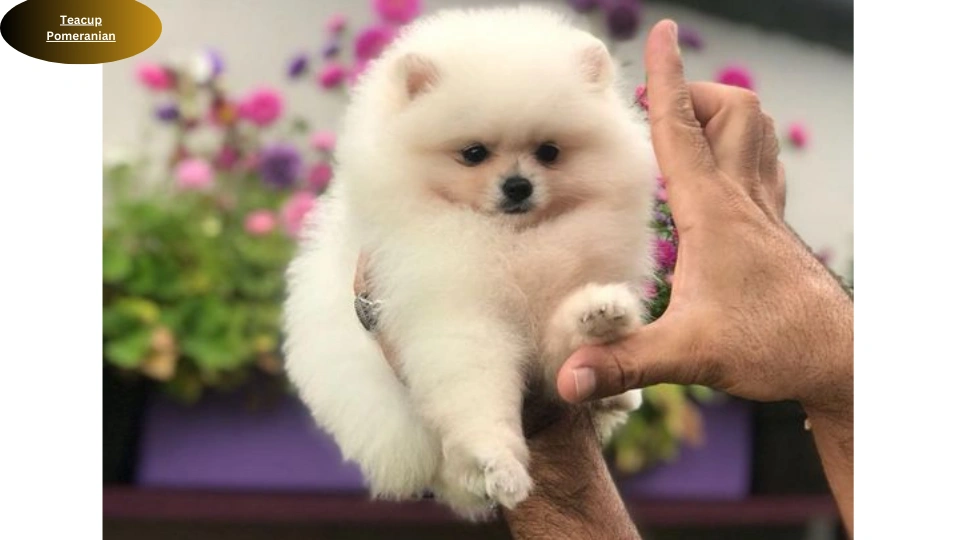
Some people mistakenly think that a Teacup Pomeranian is just another name for a regular-sized Pomeranian. It refers to a very small Pomeranian that looks like a tiny teddy bear, with a fluffy coat and a short snout.
The confusion happens when people incorrectly call a normal-sized Pomeranian from a good breeder a Teacup. Some think that a show-sized Pomeranian is called a Teacup Pomeranian. Pomeranians, in general, are small and lovely dogs that love to cuddle. These little dogs stay cute like puppies even when they grow up.
Pomeranians are cute and cuddly pets with soft, fluffy fur. They have a special double coat that makes them look extra fluffy, especially on their shoulders, chest, and neck. Their back has longer fur, and their tail has beautiful, long hair.
These dogs also have tiny ears hidden in a fluffy mane, making them look like little lions, and their eyes are sparkling and almond-shaped.
When people ask about Teacup Pomeranian puppies for sale, they usually want a Pomeranian that follows the right show-type standards. They hope that by asking for a Teacup Pomeranian, they won’t end up with a small puppy that grows bigger than the standard size and appearance, avoiding disappointment.
Teacup Pomeranian Life span
Because tiny Pomeranians like Teacup Pomeranians often have serious health problems, they usually don’t live as long as regular-sized Pomeranians. Pomeranians are small, and because of that, they usually live longer than other types of dogs.
Teacup Pomeranian Size
According to the American Kennel Club:
- Male Pomeranians should weigh between 1.8 kg and 2 kg.
- Female Pomeranians should weigh between 2 kg and 2.5 kg.
- In the United States, adult Pomeranians generally weigh between 3 and 7 lbs.
- Newborn Pomeranian puppies typically weigh between 2 and 5 oz.
- The typical height for grown-up male and female Pomeranians is around 8 to 11 inches.
This little dog usually grows to be between 3 and 7 lbs and is about 8 to 11 inches tall. If a Mini Teacup Pomeranian is a show-type, the adult Teacup Pomeranian’s size and height will be similar to show Pomeranians.
What’s special about Pomeranians is that, unlike other dogs, the girls are a bit bigger than the boys according to the standard.
I would expect a petite Pom puppy to reach its adult size between 18 months and 2 years old. Based on my extensive background in Pomeranian breeding spanning many decades, I’ve observed that smaller pups often undergo a slower and more extended growth period compared to their larger littermates.
Pomeranian Growth Chart
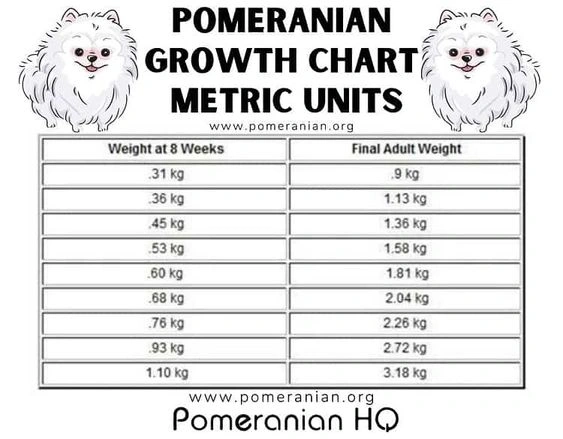
Teacup Pomeranian Colors
Cute Teacup puppies come in many beautiful colors recognized by the American Kennel Club, like:
- Cream Teacup Pomeranians.
- Small Teacup Pomeranian white.
- Brown Teacup Pomeranians.
- Teacup Pomeranian black and white.
- Parti-colored Teacup Pomeranians.
- Black Teacup Poms.
- Teacup Pomeranians in orange or tan.
- Blue Merle Teacup Pomeranians.
- Sable Teacup Pomeranians.
Pomeranian Teacup Behavior
To know how Pomeranians behave, it’s important to look at their history. Even though it’s called a small teacup Pomeranian, it originally comes from big sled dogs.
Teacup Pomeranian Personality
Pomeranians are known for being active, friendly, and playful. They are loyal, social, playful, and have a protective side. Teacup Poms, though small, are full of energy and love activities like walking and playing.

Because they enjoy playing, they make great companions for short walks. They walk proudly, excited to meet people. Keep their exercise sessions short, and many Teacup Poms like going out in a backpack. Even though Pomeranians are small, they have big personalities.
They’re smart, so don’t underestimate them based on size. They have a unique intelligence and think highly of themselves. Because they think highly of themselves, these dogs might get into fights with bigger dogs, believing they can be guard dogs despite their small size – this is called small dog syndrome.
To fix their behavior, it’s important to let them meet people and other dogs early on. Training them when they’re young helps them understand things better and stay happy. Although these smart dogs love their families and playing, they might be a bit cautious around strangers and other dogs.
When they’re with kids, grown-ups need to be there and watch over them. It’s really important to know that tiny Pomeranians aren’t a good match for little kids. Since they’re small, they can easily get hurt if a young child isn’t careful.
Do Teacup Pomeranians Lose Their Fur?
Yes, Teacup Pomeranians do shed, but not too much. They have a thick double coat: a soft undercoat and a longer outer coat that makes them look lovely. Cleaning up after them is not too hard.
Because they’re small and have less fur than bigger dogs, they don’t shed as much. Usually, males lose their fur once a year, and females might shed during their heat cycles or if they’re stressed.
They don’t need a lot of grooming; just brush them twice a week to remove loose hair, spread oils, and keep them free from dust, dirt, and fleas. Use a wire slicker brush or a metal comb for grooming to keep their coat healthy and tidy.
Excessive Barking Common in Teacup Pomeranians?
Pomeranians bark loudly and are good at alerting their human family members about possible intruders, making them suitable as guard dogs.
Traits of Teacup Puppies
| Traits | Description |
|---|---|
| Size | Very small, typically under 5 pounds |
| Appearance | Cute and fluffy with a round face |
| Temperament | Playful, affectionate, and sometimes stubborn |
| Lifespan | About 12 to 16 years |
| Health Issues | Dental problems, hypoglycemia, joint issues |
| Exercise Needs | Moderate due to their small size |
| Grooming Requirements | Regular grooming for their fluffy coat |
| Training | Intelligent but may require patience |
| Socialization | Early and consistent socialization needed |
Take Care of a Teacup Pomeranian
To properly care for a Teacup Pomeranian, it’s essential to prioritize its dietary needs, ensure it receives ample sleep for around 14 hours daily, take cautious walks on safe paths, provide consistent training, and schedule routine vet check-ups.
Here’s how you can ensure the well-being of your Teacup Pomeranian:
- Pay close attention to its diet, opting for a fiber-rich selection including ingredients like eggs, chicken, fruits, and vegetables to meet its nutritional requirements.
- Recognize that Teacup Pomeranians tire easily, necessitating adequate rest and sleep, typically around 14 hours per day.
- When taking them for walks, be mindful of their small size and vulnerability, protecting them from potential hazards like cars, traffic, and crowds.
- Don’t neglect training just because of their size; consistent training is crucial for preventing the development of undesirable behaviors.
- Schedule regular veterinary check-ups to safeguard your pup from potential illnesses and ensure its ongoing health and well-being.
Health Problems of Teacup Pomeranians
Small animals often face problems, especially with their health, and get sick more easily compared to bigger animals of the same breed.
Health Problems in Teacup Pomeranians May Involve
- Dislocated kneecaps.
- Collapsed windpipe.
- Backward sneezing.
- Hair loss or skin discoloration.
- Cushing’s syndrome.
- Low thyroid function.
- Heart ailments.
- Vision problems.
- Epileptic fits.
- Low blood sugar.
- Liver abnormalities.
- Unfused skull.
- Dental problems.
- Abnormalities in reproductive organ descent.
Reasons for the Passing of Most Teacup Dogs
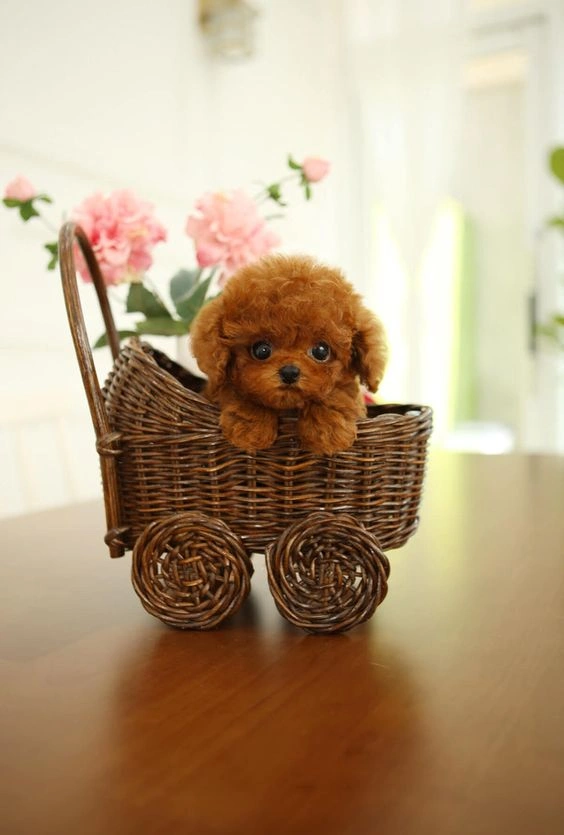
Teacup dogs can pass away because of different health problems like injuries, viruses, and stomach issues. Accidental falls, like slipping from your arms or furniture, can also be dangerous. To keep our pets safe, we need to take good care of them.
Are Teacup Pomeranians in Good Health?
Tiny Pomeranians need extra care because they’re more fragile than regular ones. They often have health problems that can affect their growth and might need more visits to the vet, which can cost a lot.
If you want a very small Pomeranian (weighing less than 4 pounds as an adult), make sure you get a healthy and lively puppy. It’s best to see the puppy in person before buying it and ask how old it is. Usually, Pomeranian puppies shouldn’t leave their mom until they’re at least eight weeks old, but very small ones should stay with the breeder until they’re 10 to 12 weeks old.
When choosing a Pomeranian as a pet, it’s important to pick the healthiest one. Losing a beloved pet too soon can be hard for everyone in the family.
Pomeranians, also known as teacup Poms, might have hypoallergenic characteristics, but it’s essential to understand that there isn’t a universally hypoallergenic dog breed.
Breeding Teacup Pomeranians
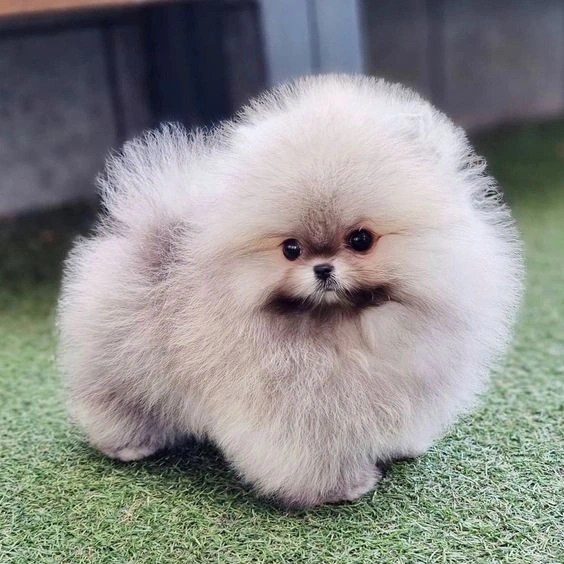
Breeding very small Pomeranians often poses challenges. Natural whelping may not be feasible, requiring veterinary assistance and incurring significant vet bills.
The smallest puppies in a litter often struggle to nurse from their mother, as larger siblings tend to dominate access to the teats. Human intervention, such as tube feeding for weak puppies or bottle feeding for stronger ones, becomes necessary for their survival.
In many animal species, the smaller members of a litter are referred to as “runts.” Runts are typically not considered for breeding and are not actively promoted. A reputable breeding program aims to minimize the presence of runts in litters.
Having a Teacup Pomeranian
Pros
- Teacup Pomeranians are smart.
- Feeding them is not costly.
- They are charming and loving.
- Despite their small size, they have big personalities.
- Easy to hug and hold.
- They don’t require much exercise.
- Suitable for small homes.
- Can be taken almost anywhere.
- Enjoy traveling in a bag or backpack
Cons
- Teacup Pomeranians may face health issues.
- Getting a Teacup Pomeranian can be pricier than other types.
- Not ideal for families with small kids.
- Teaching them bathroom habits can be challenging.
- They are typically cheerful and noisy.
- Their lifespan is short.
- Not suitable for long walks or runs.
- Homes with many stairs may not be suitable for these small dogs
Can you Buy a Teacup?
Getting a Teacup Pomeranian can cost a lot of money. If you’re saving up for one, it’s important to do some research before buying to make sure it’s worth the money for adoption and taking care of it.
Think about the expenses of having this cute little dog before rushing to get one. Puppies in general are expensive, and Pomeranians, in particular, need special care because they are small. They have extra needs for food, exercise, and grooming, and if not taken care of properly, they can have health problems like dental issues.
Remember that the costs of having a puppy don’t stop after you get it. You’ll need to keep buying food, take them to the vet, and get them toys. But in return, they’ll become your best friend. It’s okay to wait until you have enough money before getting an expensive pet. Just because famous people like Paris Hilton have them doesn’t mean you should copy them and get into a lot of debt.
Choosing to adopt a puppy from a shelter is cheaper than buying one. If you want a small dog like a Teacup Pomeranian, you might have to wait for a while, as these dogs are not as common in rescue shelters, especially the smaller ones.
Are you looking for a white teacup Pomeranian or a tiny toy Pomeranian to buy? It’s important to know about Pomeranian breeds before you start looking.
For people looking for a Pomeranian puppy: Don’t look for or consider ads for teacup Pomeranian puppies or teacup dogs. If you want a teacup Pomeranian breeder, you’re probably looking for a show or preservation breeder. It’s best to buy a Pomeranian from reputable show Pomeranian puppy breeders.
These breeders raise dogs that closely match the Pomeranian breed standard. Puppies from them usually grow to be between 3 and 7 lbs. Puppies advertised as teacup dogs are often very small and can have health problems and shorter lives.
Before you buy, ask the breeder about:
- Health tests are done on the parents before breeding.
- Official papers showing the parents’ pedigree.
- Whether the puppy’s parents’ DNA is known.
Teacup Pomeranian Price and Puppy Costs
Even though the Teacup Pomeranian isn’t officially recognized as a breed, it’s still quite expensive. These tiny pups usually cost between $2000 and $5000.
The price of Teacup Pomeranian puppies depends on things like their color, gender, where the breeder is located, and whether their parents are champions. As a breeder, I often get asked about getting a female white Teacup Pomeranian puppy.
The American Kennel Club says you could spend over $20,000 on your dog throughout its life. This includes things like good food, vet visits, toys, grooming, and training, and if your Teacup puppy gets sick, the costs can be much higher.
Discover the charm of Teacup Pomeranians for sale UK – pint-sized bundles of fluff ready to fill your home with love and cuddles!
Reasons to Avoid Purchasing a Teacup Pomeranian Puppy
Buying a “Teacup Pomeranian” might give you a sick dog. Taking care of a dog with health issues can be expensive and sad.
Here’s why it’s not a good idea to get a “Teacup Pomeranian.” The AKC has rules about how big dogs should be, so if your new puppy is smaller than what they say is normal, it could mean the dog is not healthy.
Pomeranian vs. Teacup Pomeranian
This article is about comparing regular Pomeranians with Teacup Pomeranian puppies. It’s for people who love dogs and want to get a new puppy.
Regular Pomeranians are small dogs that are lively, smart, and friendly. Some people think Teacup Pomeranians are just smaller versions of regular Pomeranians, but that’s not true.
Keep reading to find out why this idea is wrong and to understand the differences between tiny Teacups and regular Pomeranian puppies.
Are Teacup Pomeranians Real?

Some people think teacup dogs like Pomeranians and teacup yorkie are different types of dogs. But that’s not true; they’re just smaller versions of the terrier or toy dog types of these well-known breeds.
The Teacup Pomeranian is not an officially recognized type of dog. The term “Teacup Pomeranian” is often used to describe these small and cute puppies for marketing purposes.
Preservation Pomeranian breeders are the ones who breed these adorable Teacup Pomeranians. A Teacup Pomeranian full grown typically stands at 6–7 inches tall and weighs between 3–7 pounds.
Meet Teacup Chihuahuas – tiny, adorable dogs that bring big smiles and lots of love into your home.
Facts
- The Teacup Pomeranian is a smaller version of the regular Pomeranian, not a separate breed.
- They typically weigh between 3 to 7 pounds and stand about 8 to 11 inches tall.
- Teacup Pomeranians are loved for their small size, loyalty, and intelligence.
- Their fur comes in various colors, including cream, white, brown, and more.
- Early training and socializing are important for their behavior.
- Sometimes, they can exhibit aggression due to feeling overly important.
- Prices can range from $2000 to $5000 based on factors like color and pedigree.
- It’s recommended to find a reputable breeder instead of relying on ads for these dogs.
Find adorable Teacup Pomeranian for sale from trusted breeders or adoption centers.
Frequently Asked Question
How Long Do Teacup Poms Live?
Both typical Pomeranians and Teacup Pomeranians usually enjoy a lifespan of approximately 12 to 15 years. Although generally healthy, all dog breeds can be prone to certain health conditions. Teacup variations have their own set of health risks due to their smaller stature.
How Big Do Teacup Pomeranians Get?
On average, these dogs generally weigh between two to six pounds and attain a height of around 6 to 11 inches. They typically reach their adult size by approximately 9-10 months old, with the most substantial weight gain occurring within their first four to five months.
How Much is the Teacup Pomeranian?
Teacup Pomeranians can be priced anywhere from $1500 to over $6500. The cost depends on things like where you’re buying from, the puppy’s age, gender, color, and health.
How Big Do Teacup Pomeranian Get?
Note: If you love Teacup Pomeranians, choose a caring breeder who looks after their health. Regular vet visits and a loving home are crucial for a happy and healthy Teacup Pomeranian.
Sources
Immune Deficiency in a Pomeranian
I am a dedicated content writer with more than five years of experience, particularly skilled in the art of storytelling. My writing journey commenced during my college years, where I pursued journalism and unearthed my talent for creating captivating narratives.

